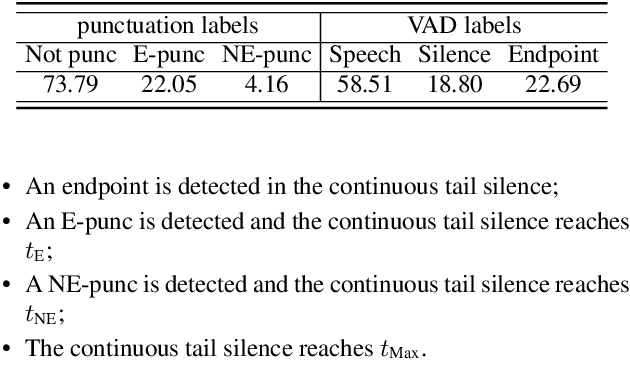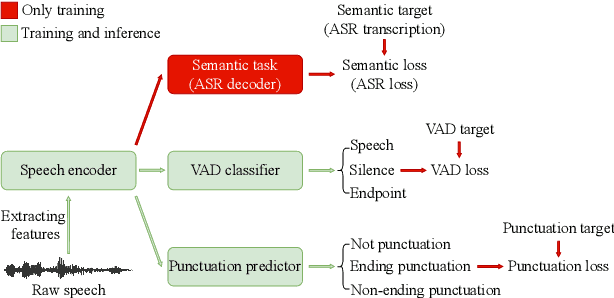Mohan Shi
CHSER: A Dataset and Case Study on Generative Speech Error Correction for Child ASR
May 24, 2025Abstract:Automatic Speech Recognition (ASR) systems struggle with child speech due to its distinct acoustic and linguistic variability and limited availability of child speech datasets, leading to high transcription error rates. While ASR error correction (AEC) methods have improved adult speech transcription, their effectiveness on child speech remains largely unexplored. To address this, we introduce CHSER, a Generative Speech Error Correction (GenSEC) dataset for child speech, comprising 200K hypothesis-transcription pairs spanning diverse age groups and speaking styles. Results demonstrate that fine-tuning on the CHSER dataset achieves up to a 28.5% relative WER reduction in a zero-shot setting and a 13.3% reduction when applied to fine-tuned ASR systems. Additionally, our error analysis reveals that while GenSEC improves substitution and deletion errors, it struggles with insertions and child-specific disfluencies. These findings highlight the potential of GenSEC for improving child ASR.
LibriheavyMix: A 20,000-Hour Dataset for Single-Channel Reverberant Multi-Talker Speech Separation, ASR and Speaker Diarization
Sep 01, 2024



Abstract:The evolving speech processing landscape is increasingly focused on complex scenarios like meetings or cocktail parties with multiple simultaneous speakers and far-field conditions. Existing methodologies for addressing these challenges fall into two categories: multi-channel and single-channel solutions. Single-channel approaches, notable for their generality and convenience, do not require specific information about microphone arrays. This paper presents a large-scale far-field overlapping speech dataset, crafted to advance research in speech separation, recognition, and speaker diarization. This dataset is a critical resource for decoding ``Who said What and When'' in multi-talker, reverberant environments, a daunting challenge in the field. Additionally, we introduce a pipeline system encompassing speech separation, recognition, and diarization as a foundational benchmark. Evaluations on the WHAMR! dataset validate the broad applicability of the proposed data.
Advancing Multi-talker ASR Performance with Large Language Models
Aug 30, 2024



Abstract:Recognizing overlapping speech from multiple speakers in conversational scenarios is one of the most challenging problem for automatic speech recognition (ASR). Serialized output training (SOT) is a classic method to address multi-talker ASR, with the idea of concatenating transcriptions from multiple speakers according to the emission times of their speech for training. However, SOT-style transcriptions, derived from concatenating multiple related utterances in a conversation, depend significantly on modeling long contexts. Therefore, compared to traditional methods that primarily emphasize encoder performance in attention-based encoder-decoder (AED) architectures, a novel approach utilizing large language models (LLMs) that leverages the capabilities of pre-trained decoders may be better suited for such complex and challenging scenarios. In this paper, we propose an LLM-based SOT approach for multi-talker ASR, leveraging pre-trained speech encoder and LLM, fine-tuning them on multi-talker dataset using appropriate strategies. Experimental results demonstrate that our approach surpasses traditional AED-based methods on the simulated dataset LibriMix and achieves state-of-the-art performance on the evaluation set of the real-world dataset AMI, outperforming the AED model trained with 1000 times more supervised data in previous works.
SA-Paraformer: Non-autoregressive End-to-End Speaker-Attributed ASR
Oct 07, 2023Abstract:Joint modeling of multi-speaker ASR and speaker diarization has recently shown promising results in speaker-attributed automatic speech recognition (SA-ASR).Although being able to obtain state-of-the-art (SOTA) performance, most of the studies are based on an autoregressive (AR) decoder which generates tokens one-by-one and results in a large real-time factor (RTF). To speed up inference, we introduce a recently proposed non-autoregressive model Paraformer as an acoustic model in the SA-ASR model.Paraformer uses a single-step decoder to enable parallel generation, obtaining comparable performance to the SOTA AR transformer models. Besides, we propose a speaker-filling strategy to reduce speaker identification errors and adopt an inter-CTC strategy to enhance the encoder's ability in acoustic modeling. Experiments on the AliMeeting corpus show that our model outperforms the cascaded SA-ASR model by a 6.1% relative speaker-dependent character error rate (SD-CER) reduction on the test set. Moreover, our model achieves a comparable SD-CER of 34.8% with only 1/10 RTF compared with the SOTA joint AR SA-ASR model.
The second multi-channel multi-party meeting transcription challenge 2.0): A benchmark for speaker-attributed ASR
Sep 24, 2023



Abstract:With the success of the first Multi-channel Multi-party Meeting Transcription challenge (M2MeT), the second M2MeT challenge (M2MeT 2.0) held in ASRU2023 particularly aims to tackle the complex task of speaker-attributed ASR (SA-ASR), which directly addresses the practical and challenging problem of "who spoke what at when" at typical meeting scenario. We particularly established two sub-tracks. 1) The fixed training condition sub-track, where the training data is constrained to predetermined datasets, but participants can use any open-source pre-trained model. 2) The open training condition sub-track, which allows for the use of all available data and models. In addition, we release a new 10-hour test set for challenge ranking. This paper provides an overview of the dataset, track settings, results, and analysis of submitted systems, as a benchmark to show the current state of speaker-attributed ASR.
Semantic VAD: Low-Latency Voice Activity Detection for Speech Interaction
May 21, 2023



Abstract:For speech interaction, voice activity detection (VAD) is often used as a front-end. However, traditional VAD algorithms usually need to wait for a continuous tail silence to reach a preset maximum duration before segmentation, resulting in a large latency that affects user experience. In this paper, we propose a novel semantic VAD for low-latency segmentation. Different from existing methods, a frame-level punctuation prediction task is added to the semantic VAD, and the artificial endpoint is included in the classification category in addition to the often-used speech presence and absence. To enhance the semantic information of the model, we also incorporate an automatic speech recognition (ASR) related semantic loss. Evaluations on an internal dataset show that the proposed method can reduce the average latency by 53.3% without significant deterioration of character error rate in the back-end ASR compared to the traditional VAD approach.
CASA-ASR: Context-Aware Speaker-Attributed ASR
May 21, 2023



Abstract:Recently, speaker-attributed automatic speech recognition (SA-ASR) has attracted a wide attention, which aims at answering the question ``who spoke what''. Different from modular systems, end-to-end (E2E) SA-ASR minimizes the speaker-dependent recognition errors directly and shows a promising applicability. In this paper, we propose a context-aware SA-ASR (CASA-ASR) model by enhancing the contextual modeling ability of E2E SA-ASR. Specifically, in CASA-ASR, a contextual text encoder is involved to aggregate the semantic information of the whole utterance, and a context-dependent scorer is employed to model the speaker discriminability by contrasting with speakers in the context. In addition, a two-pass decoding strategy is further proposed to fully leverage the contextual modeling ability resulting in a better recognition performance. Experimental results on AliMeeting corpus show that the proposed CASA-ASR model outperforms the original E2E SA-ASR system with a relative improvement of 11.76% in terms of speaker-dependent character error rate.
A Comparative Study on multichannel Speaker-attributed automatic speech recognition in Multi-party Meetings
Nov 01, 2022Abstract:Speaker-attributed automatic speech recognition (SA-ASR) in multiparty meeting scenarios is one of the most valuable and challenging ASR task. It was shown that single-channel frame-level diarization with serialized output training (SC-FD-SOT), single-channel word-level diarization with SOT (SC-WD-SOT) and joint training of single-channel target-speaker separation and ASR (SC-TS-ASR) can be exploited to partially solve this problem. SC-FD-SOT obtains the speaker-attributed transcriptions by aligning the speaker diarization results with the ASR hypotheses, SC-WD-SOT uses word-level diarization to get rid of the alignment dependence on timestamps, and SC-TS-ASR jointly trains target-speaker separation and ASR modules, which achieves the best performance. In this paper, we propose three corresponding multichannel (MC) SA-ASR approaches, namely MC-FD-SOT, MC-WD-SOT and MC-TS-ASR. For different tasks/models, different multichannel data fusion strategies are considered, including channel-level cross-channel attention for MC-FD-SOT, frame-level cross-channel attention for MC-WD-SOT and neural beamforming for MC-TS-ASR. Experimental results on the AliMeeting corpus reveal that our proposed multichannel SA-ASR models can consistently outperform the corresponding single-channel counterparts in terms of the speaker-dependent character error rate (SD-CER).
Random Pairwise Shapelets Forest
Mar 19, 2019



Abstract:Shapelet is a discriminative subsequence of time series. An advanced shapelet-based method is to embed shapelet into accurate and fast random forest. However, it shows several limitations. First, random shapelet forest requires a large training cost for split threshold searching. Second, a single shapelet provides limited information for only one branch of the decision tree, resulting in insufficient accuracy and interpretability. Third, randomized ensemble causes interpretability declining. For that, this paper presents Random Pairwise Shapelets Forest (RPSF). RPSF combines a pair of shapelets from different classes to construct random forest. It omits threshold searching to be more efficient, includes more information for each node of the forest to be more effective. Moreover, a discriminability metric, Decomposed Mean Decrease Impurity (DMDI), is proposed to identify influential region for every class. Extensive experiments show RPSF improves the accuracy and training speed of shapelet-based forest. Case studies demonstrate the interpretability of our method.
 Add to Chrome
Add to Chrome Add to Firefox
Add to Firefox Add to Edge
Add to Edge